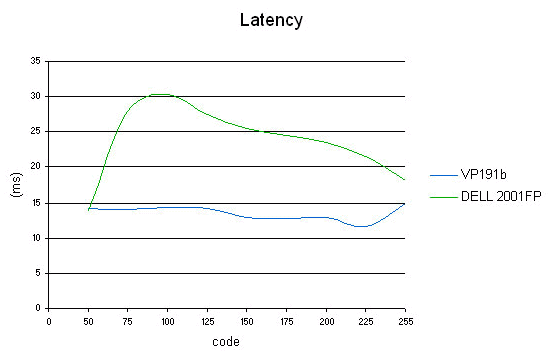NEC and LaCie Lead On Professional LCD Gear
Latency: Nothing Out Of The Ordinary
We measured actual latency of the 2001FP.

Recall, our test method once again...
This curve shows the different latency values as a function of the gray-scale level. Alternating from black to white is represented on the curve by a point with an x-coordinate of 255, black-to-grey has a value on the x-axis of 125, black-to-dark grey displays as 50, etc. The official ISO latency specified by the manufacturer only covers black/white transitions (0/255). Although the value we measured agrees with the manufacturer on this point, that's not of much use in judging the actual responsiveness of the panel in real world use.
The results are nothing extraordinary, unfortunately. The display went west for 16 ms before coming back puffing and wheezing and then just grazed in at 31 ms in the worst cases. With those figures, movies and video games will certainly expose this panel's performance limitations.
In Practice
Let's start with the positives. As a CAD monitor this product would be a good choice; the colors are saturated, so it's very suitable for AutoCad or Cadence. Even so, we'd strongly recommend using the DVI input. High precision users of Cadence Virtuoso, for example, will notice video noise around the trace lines at some zoom factors. This can be overcome by fiddling with the refresh rate, but then you lose clarity in text editing, so it's a better idea to just use a DVI cable. If you do stick with VGA, note that the 2001FP is very sensitive to the quality of the VGA cable.
For office use, the panel is impeccable; the swivel is very practical, and it's easy to find a comfortable working position. Viewing angles are wide enough to remove the need for precise tilting of the panel. Text is clear, but I'd recommend using a DVI connection for anything digital.
Stay on the Cutting Edge
Join the experts who read Tom's Hardware for the inside track on enthusiast PC tech news — and have for over 25 years. We'll send breaking news and in-depth reviews of CPUs, GPUs, AI, maker hardware and more straight to your inbox.
Now the things to get angry about! This monitor could be used for photo retouching but, let's just say, it's not the best. First off, you can't adjust the warmth of the colors to your taste: only presets of 6500K and 7500K are provided. Next, the screen is lacking a little in its dynamics, so it can't display fine detail well, and this applies most of all to dark shades in photos. This is a pity because, for the price, we could have been looking here at the bargain of the century for photographers.
That said, it's a fully functional product, but if you're looking for your dream photo retouching solution, this isn't it.
Video isn't this monitor's strong point either. The nominal 16 ms latency we observed when fully optimized doesn't prevent some lags during video playback. The colors are bright, but not always entirely accurate.
Ditto again for video games. It's not the fastest monitor in the galaxy and that disqualifies it. Furthermore, the interpolation is frankly a setback. The monitor is enough for a limited knock about between workmates, but not for an intensive game. Of course, it wasn't designed for that.
Conclusion
In the end, the 2001FP is a good monitor for CAD, but it's hardly convincing in the photo arena. Obviously, there's also the problem with DVI, which is absolutely necessary with this product to deliver its full potential. And there everything is going to depend on the policy of your company. If your workstations are not designed to use DVI, the 2001FP risks losing the majority vote from your CAD staff.
Current page: Latency: Nothing Out Of The Ordinary
Prev Page Spatial Uniformity Next Page LaCie 321, NEC 2180UX: Same Old BattleMost Popular

